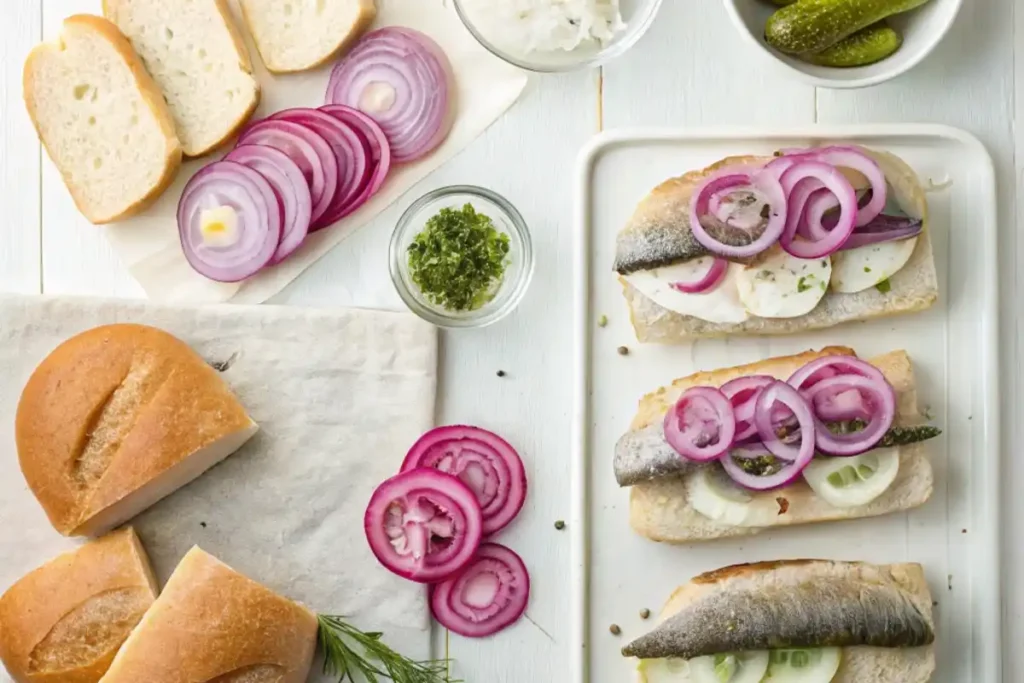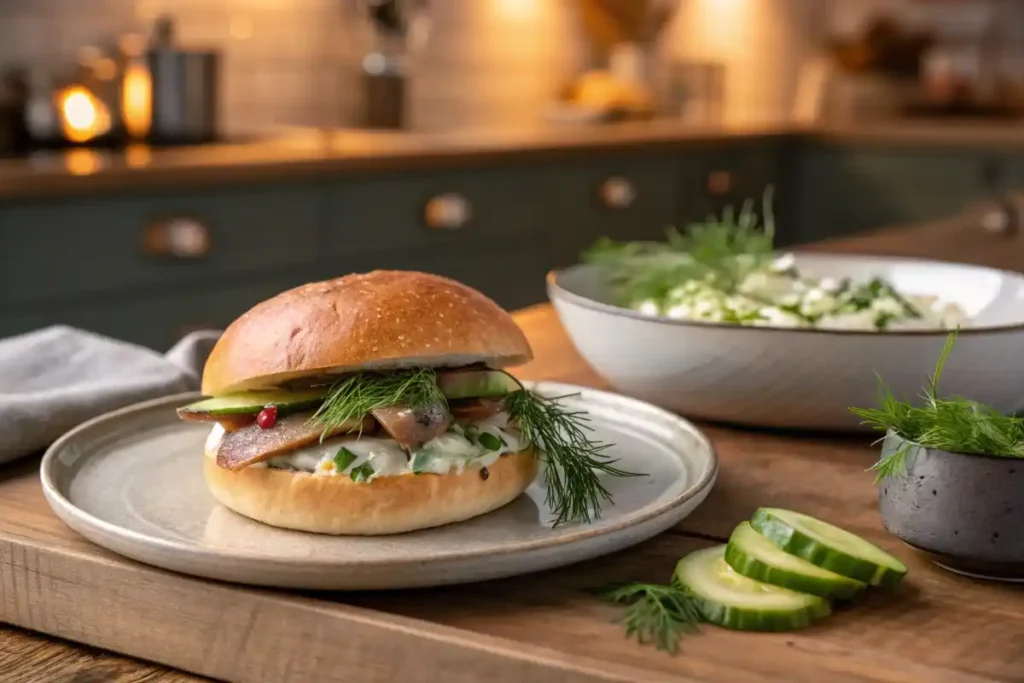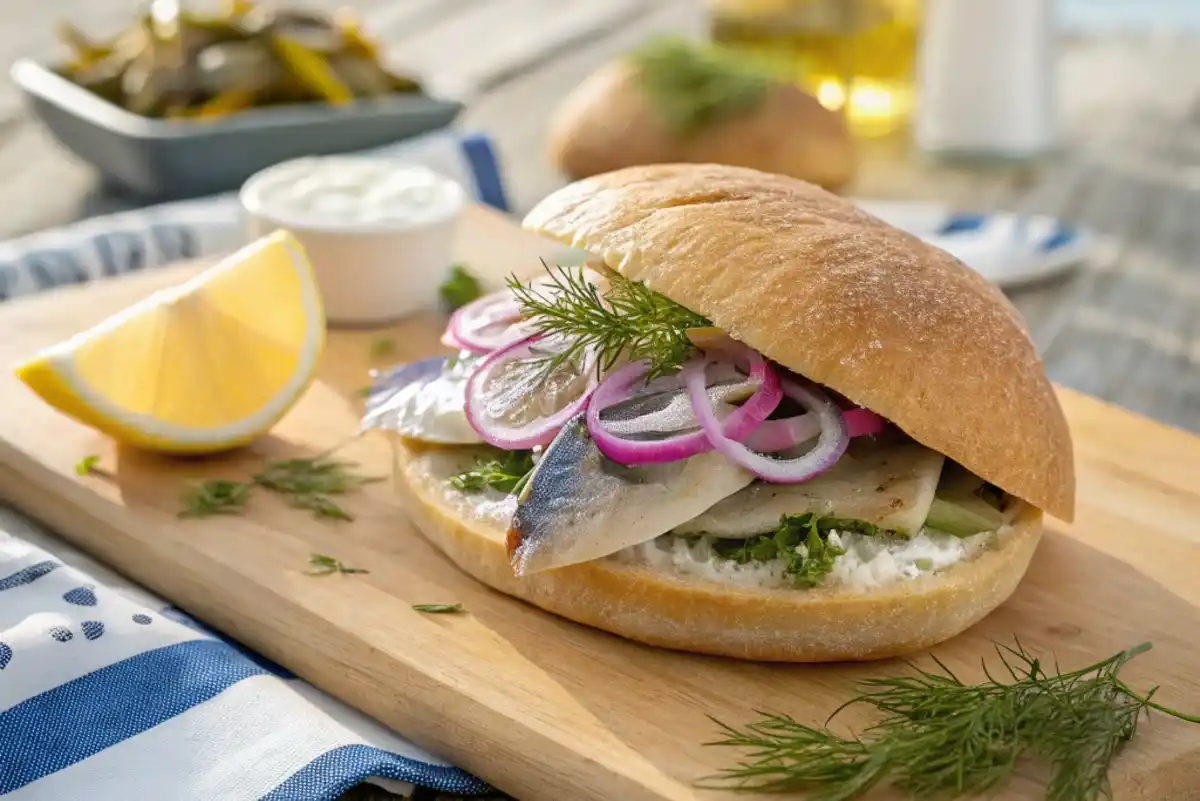If you’ve ever craved a taste of coastal German cuisine, you’re in for a treat with the Matjesbrötchen recipe. This classic sandwich, brimming with fresh flavors of pickled herring, crunchy onions, and pillowy-soft rolls, is a beloved street food staple in northern Germany. More than a dish, Matjesbrötchen is a delicious cultural experience, offering a perfect blend of salty, tangy, and fresh flavors.
This article walks you through every step of making an authentic Matjesbrötchen. From understanding its history to perfecting each layer of the sandwich, we’ll leave no detail unexplored. You’ll also discover customization options, tips for crafting the perfect sandwich, and answers to frequently asked questions, so you can enjoy this delicious German specialty like a pro.
Without further ado, let’s jump into what makes Matjesbrötchen so iconic!
Table of contents
What is Matjesbrötchen?
The Matjesbrötchen is no ordinary sandwich. It’s a German coastal delicacy made with matjes herring—a young, tender, and lightly salted pickled fish. Typically served in a crusty roll and topped with fresh red onions, crunchy pickles, and aromatic herbs, it’s more than just a quick bite. This iconic dish represents the heart of German street food, especially in cities near the North Sea like Hamburg or Bremen.
Matjes herring is prized for its mild flavor and delicate texture. Unlike heavily smoked or cured fish, matjes is marinated in a special brine of vinegar, salt, and spices, creating a rich yet tangy taste that complements simple sandwich ingredients beautifully.
Key Components of Matjesbrötchen
The essence of this sandwich lies in its core ingredients: soft rolls, matjes herring, and fresh toppings like onions and herbs. These components are intentionally simple to highlight the rich flavor of the herring. Additional toppings, such as lemon wedges or mustard, allow you to tweak the taste to suit your palate.
For an authentic experience, it’s best to use a classic German Brötchen roll, though Kaiser rolls or other soft white breads work well.
Cultural Significance in German Cuisine
The Matjesbrötchen recipe is deeply rooted in German culture, especially in regions with a strong fishing heritage. Fishermen traditionally enjoyed these sandwiches as a quick, nutritious meal during long workdays. Over time, this humble fare evolved into a beloved street food enjoyed by locals and tourists alike. Whether you grab one from a seaside market stall or prepare it at home, you’ll taste a bit of Germany’s history with every bite.
In short, Matjesbrötchen is more than a dish—it’s a flavorful tribute to Germany’s rich maritime culture.
Ingredients for Matjesbrötchen
Essential Ingredients
Creating the perfect Matjesbrötchen recipe starts with choosing the right ingredients. The star of the show is matjes herring, a young pickled fish with a tender texture and mildly salty flavor. To build the sandwich, you’ll also need fresh rolls, preferably Brötchen or soft Kaiser rolls, which provide the perfect balance of fluffiness and chewiness.
Toppings like red onions, thinly sliced for their tangy bite, and pickles, adding crunch and a touch of acidity, elevate the sandwich. Don’t forget optional spreads such as mustard or butter, which enhance the richness and depth of flavor.
Optional Add-ons for Flavor
To customize your Matjesbrötchen, consider adding garnishes like fresh dill or parsley for an herbal note. A squeeze of lemon juice can brighten the dish, while horseradish delivers a spicy kick. These small touches let you tweak the recipe to suit your taste.
Choosing the Best Ingredients
The quality of your ingredients matters! Look for fresh, high-quality matjes herring, preferably sourced from a trusted fishmonger or specialty store. When selecting rolls, opt for ones with a sturdy crust that can hold the filling without becoming soggy. Similarly, fresh vegetables and herbs make a noticeable difference in the sandwich’s overall flavor.
For more inspiration, check out this guide to crafting delicious seafood dishes.
Step-by-Step Guide to Making Matjesbrötchen

Step 1: Preparing the Matjes Herring
Start by draining the matjes herring fillets from their brine. If the flavor feels too strong, give them a quick rinse under cold water, but many purists prefer the bold taste as-is. Slice the herring into manageable, bite-sized pieces to ensure every sandwich bite is evenly flavored.
Step 2: Preparing the Vegetables
Next, thinly slice your red onion. For a milder onion flavor, soak the slices in cold water for about 10 minutes. Chop the pickles into thin slices or small chunks, depending on your preference for texture.
Step 3: Preparing the Rolls
Take your fresh rolls and slice them horizontally. You can toast them lightly if you prefer a bit of crunch. Spread a thin layer of butter or mustard on the insides to add moisture and enhance the flavor.
Step 4: Assembling the Sandwich
Now comes the fun part: layering! Place a few pieces of herring on the bottom half of the roll. Add the sliced onions and pickles, spreading them evenly. If you’re using herbs like dill or parsley, sprinkle them generously over the filling. Finish with a squeeze of lemon juice for a zesty twist.
Step 5: Serving Suggestions
Close the roll gently and serve immediately. Matjesbrötchen pairs beautifully with crispy fries, a light salad, or even a hearty soup. Alternatively, enjoy it as a stand-alone snack alongside a refreshing glass of cold beer or sparkling water.
By following these steps, you’ll master the Matjesbrötchen recipe in no time, creating a dish that’s both easy to make and utterly satisfying.
For those looking for additional sandwich inspiration, this guide to unique bread recipes might spark your creativity!
Customizing Your Matjesbrötchen
Variations for Different Tastes
The Matjesbrötchen recipe is incredibly versatile, allowing you to tweak it based on personal preferences. For a creamy touch, try adding a dollop of sour cream or a light spread of cream cheese before assembling the sandwich. Prefer a spicier kick? Add a hint of horseradish or a dash of chili flakes for heat. To make it heartier, layer in thin slices of boiled egg or avocado for a rich, velvety texture.
Substituting Ingredients
If you can’t find matjes herring, don’t fret—there are alternatives! Substitute with other pickled fish like rollmops or even smoked salmon for a different flavor profile. For the bread, gluten-free rolls can replace traditional ones, ensuring everyone can enjoy this delicious dish.
Vegetarian? Swap the fish with marinated tofu or grilled eggplant slices. With these substitutions, the essence of the sandwich is preserved while catering to dietary needs.
Dietary Adjustments
For a lighter option, consider using whole-grain rolls or reducing the butter and pickle quantities. Those watching their sodium intake can rinse the herring more thoroughly and opt for unsalted bread. No matter your dietary preference, the Matjesbrötchen recipe can be tailored to your taste.
For more culinary inspiration, explore our guide to balanced snacks for ideas to pair with this sandwich.
Tips for Perfect Matjesbrötchen Every Time
Using Fresh Ingredients
Freshness is the key to a standout Matjesbrötchen recipe. From the fish to the bread, each component should be top-notch to achieve the perfect bite. Fresh herbs, crisp onions, and soft rolls can transform a good sandwich into a truly unforgettable one.
Flavor Balancing Tips
To get the right balance of flavors, remember this: tangy complements salty. The acidity of lemon juice or mustard pairs beautifully with the salty richness of matjes herring. Meanwhile, the sweetness of red onions offsets the savory notes, creating a well-rounded taste experience.
Common Mistakes to Avoid
Avoid overloading the sandwich. While it’s tempting to pack in extra toppings, too many layers can overwhelm the delicate flavors of the herring. Additionally, don’t skip toasting the bread lightly—it prevents sogginess and adds texture.
If you’re a fan of experimenting, you might also enjoy this salmon crudo recipe for another seafood delight to add to your repertoire.
By following these tips, you’ll craft a Matjesbrötchen that’s not only authentic but also irresistibly delicious!
FAQs About Matjesbrötchen

What Makes a Matjesbrötchen Recipe Authentic?
Authenticity lies in the details. A true Matjesbrötchen recipe features young, lightly pickled matjes herring, which gives the sandwich its signature mild and tangy flavor. Traditional recipes use soft white rolls like Brötchen and include minimal but flavorful toppings, such as red onions, pickles, and fresh herbs. Staying true to these elements ensures you’re enjoying an authentic German culinary experience.
How Can I Make Matjesbrötchen Recipe Easier?
To simplify the process, opt for pre-sliced matjes herring and pre-packaged rolls. Many grocery stores carry pickled herring that’s ready to use, cutting down preparation time. Instead of assembling multiple fresh ingredients, you can use prepared spreads like herbed cream cheese for a quicker version. This way, you can whip up the sandwich in just minutes.
Can I Prepare Matjesbrötchen Ahead of Time?
While this sandwich is best enjoyed fresh, you can prepare the components in advance. Slice the herring, onions, and pickles, storing them in airtight containers in the fridge. When ready to eat, assemble the sandwich quickly to maintain the bread’s freshness. For optimal flavor, avoid adding wet ingredients like lemon juice or mustard until just before serving.
What Side Dishes Pair Best with Matjesbrötchen?
Matjesbrötchen pairs wonderfully with light and crispy sides. Classic options include a side of fries or a tangy cucumber salad. For a heartier option, serve it alongside creamy potato salad or a cup of hearty soup. These pairings complement the sandwich’s bright and tangy flavors while adding variety to your meal.
Exploring German Sandwich Culture
Popular German Sandwiches Beyond Matjesbrötchen
Germany is home to a variety of iconic sandwiches beyond the Matjesbrötchen recipe. For example, the Leberkäse Semmel features thick slices of meatloaf served in a crusty roll, often enjoyed with mustard. Another popular choice is the Fischbrötchen, a seafood sandwich similar to Matjesbrötchen but made with smoked fish, shrimp, or crab.
Regional specialties, such as the Halbes Hähnchen sandwich in Bavaria or the open-faced rye bread sandwiches in the Rhineland, highlight the country’s diverse culinary traditions.
Matjesbrötchen and German Coastal Cuisine
The Matjesbrötchen recipe is a cornerstone of northern Germany’s coastal cuisine, where the abundance of fresh fish has shaped local dishes for centuries. Served at fish markets, seaside cafes, and street food stalls, this sandwich captures the essence of life by the sea. Its simple, fresh ingredients reflect a time-honored tradition of making the most of local resources.
For food lovers seeking to explore more German-inspired dishes, trying a broader range of regional sandwiches can offer a deeper appreciation of the country’s food culture. A taste of Matjesbrötchen is just the beginning of a flavorful journey through Germany’s culinary heritage!
Conclusion and Call to Action
A Final Bite of the Matjesbrötchen Recipe
The Matjesbrötchen recipe offers more than just a delicious sandwich—it’s a gateway to the rich flavors of German coastal cuisine. Whether you stick to the traditional version or customize it with your favorite toppings, this dish guarantees a perfect balance of tangy, salty, and fresh flavors.
Why You Should Try Matjesbrötchen Today
Its simplicity, health benefits, and versatility make it a must-try for anyone seeking a unique culinary experience. From beginners to seasoned cooks, anyone can create this classic German treat with just a handful of ingredients.
Explore More Recipes
Hungry for more inspiration? Dive into other regional delicacies, or share your Matjesbrötchen recipe creations with us. Don’t forget to leave a comment or explore our seafood recipe collection for more ideas. Happy cooking!
